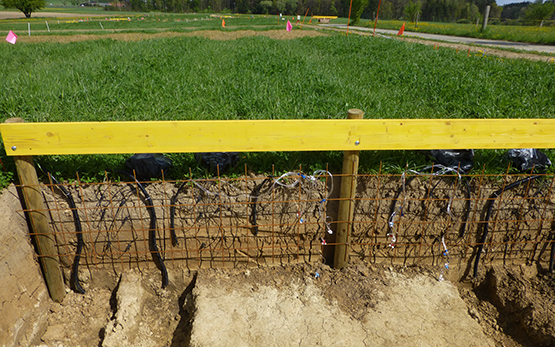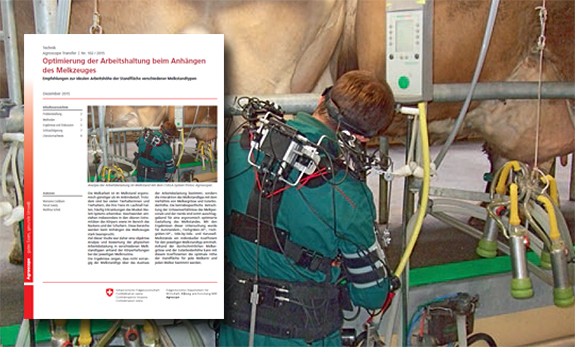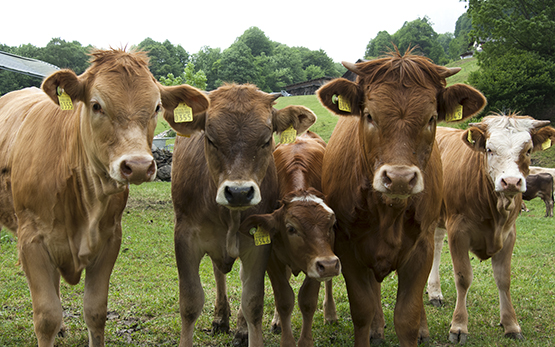Bérard J.
Environmental sustainability and use of natural resources in feed production.
Dans: FAO global forum for animal feed and feed regulators. 14 November, Rome. 2023.
Bérard J.
Environmental sustainability and use of natural resources in feed production.
Dans: FAO Global forum for animal feed and feed regulators. 14 November, Rome. 2023, 1-13.
Foggi G., Turini L., Dohme-Meier F., Muenger A., Eggerschwiler L., Bérard J., Conte G., Buccioni A., Mele M.
In vivo evaluation of tannins and essential oils mixtures as additives for dairy cows.
Dans: Book of Abstracts of the 74th Annual Meeting of the European Federation of Animal Science. 26 August – 1 September, Ed. EAAP, 2023, 567.
Bérard J.
EAAP and the drivers of change in the livestock sector.
Dans: FAO Global Conference on Sustainable Livestock Transformation. 25 September, Rome. 2023, 1-13.
Zehnder T., Schneider M. K., Lüscher A., Giller K., Silacci P., Messadène-Chelali J., Bérard J., Kreuzer M.
The effects of Alnus viridis encroachment in mountain pastures on the growth performance, carcass and meat quality of Dexter cattle and Engadine sheep.
Animal Production Science, 63, (12), 2023, 1248-1260.
Niero G., Visentin G., Censi S., Righi F., Manuelian C. L., Formigoni A., Milan C., Bérard J., Cassandro M., Penasa M., Moore S., Costa A., De Marchi M.
Invited review: Iodine level in dairy products: A feed-to-fork overview.
Journal of Dairy Science, 106, (4), 2023, 2213-2229.
Kapp-Bitter A. N., Bérard J., Amelchanka S. L., Baki C., Kunz C., Steiner A. K., Kreuzer M., Leiber F.
Effects of dietary Sanguisorba minor, Plantago lanceolata, and Lotus corniculatus on urinary N excretion of dairy cows.
Animal Production Science, In Press, 2023, 1-11.
Gobbo Oiveira Erünlü N., Rieder S., Kuntzer T., Bérard J., Wellnitz O.
Effects of sensor ear tags with twin pin fixing system on health and well-being of cattle.
Schweizer Archiv für Tierheilkunde, 165, (7/8), 2023, 512-523.
Ueda K., Heikkilä U., Kuntzer T., Gobbo Oliveira Erünlü N., Bérard J., Wellnitz O., Beglinger C., Rieder S.
Fernkontrolle von Rindern in der Schweiz mittels einer Sensorohrmarke.
Agrarforschung Schweiz, Agrarforschung Schweiz, (14), 2023, 104-115.
Manzocchi E., Ferlay A., Farizon Y., Enjalbert F., Bouchon M., Giller K., Kreuzer M., Bérard J., Martin B., Coppa M.
Herbage utilization method affects rumen fluid and milk fatty acid profile in Holstein and Montbéliarde cows.
Animal, 16, (12), 2022, 1-12.
Pauler C., Lüscher A., Kreuzer M., Bérard J., Schneider M. K.
Robust cattle, sheep and goats in green alder shrubs – or how to preserve mountain pastures.
Grassland Science in Europe, 27, 2022, 247-249.
Pauler C., Lüscher A., Kreuzer M., Bérard J., Schneider M. K.
Robust livestock in green alder shrubs – or how to preserve mountain pastures.
Dans: 29th general meeting. 26. Juni, Ed. European Grassland Federation EGF, Caen, France. 2022, 1.
Manzocchi E., Martin B., Bord C., Bouchon M., Bérard J., Coppa M., Delbès C., Verdier-Metz I.
Bacterial and botanical diversity of the pasture influence the raw milk cheese sensory properties.
Grassland Science in Europe, 27, 2022, 659-661.
Pauler C., Zehnder T., Staudinger M., Lüscher A., Kreuzer M., Bérard J., Schneider M. K.
Thinning the thickets: Foraging of hardy cattle, sheep and goats in green alder shrubs.
Journal of Applied Ecology, 59, (5), 2022, 1394-1405.
Schneider M. K., Pauler C., Bérard J.
Animal-carried sensors in mountain livestock science: opportunities and challenges.
Dans: 1st Joint Meeting of EAAP Mountain Livestock Farming & FAO-CIHEAM Mountain Pastures. 7-9 June, Ed. EAAP, virtual. 2021, 38.
Manzocchi E., Martin B., Bord C., Verdier-Metz I., Bouchon M., De Marchi M., Constant I., Giller K., Kreuzer M., Bérard J., Musci M., Coppa M.
Feeding cows with hay, silage, or fresh herbage on pasture or indoors affects sensory properties and chemical composition of milk and cheese.
Journal of Dairy Science, 104, (5), 2021, 5285-5302.
Pauler C., Isselstein J., Bérard J., Braunbeck T., Schneider M. K.
Choosy grazers and plant communities – Interactions between cattle breeds and vegetation in semi-natural pastures.
Dans: International Grassland Congress Proceedings. 25 October, Ed. Kenya Agricultural and Livestock Research Organization, Nairobi. 2021, 1-4.
Schneider M. K., Zehnder T., Bérard J., Pauler C., Staudinger M., Kreuzer M., Lüscher A.
Counteracting green alder shrub expansion by low-input grazing.
Dans: International Grassland Congress Proceedings. 25.9., Ed. Kenya Agricultural and Livestock Research Organization, Nairobi. 2021, 1-4.
Schlegel P., Walther B., Haldimann Max, Bérard J.
Le lait, source d'iode : Actions envisageables dans l'exploitation laitière pour atteindre une teneur ciblée en iode dans le lait.
Agroscope Transfer, 390, 2021, 1-8.
autres langues: allemand
Koczura M., Martin B., Musci M., Di Massimo M., Bouchon M., Turille G., Kreuzer M., Bérard J., Coppa M.
Little difference in milk fatty acid and terpene composition among three contrasting dairy breeds when grazing a biodiverse mountain pasture.
Frontiers in Veterinary Science, 7, 2020, 1-11.








